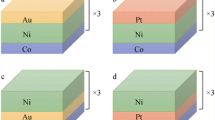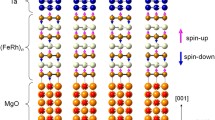Abstract
Modulating the magnetic anisotropy of ferromagnetic thin films is crucial for constructing high-density and energy efficient magnetic memory devices. Ta/W(N)/Co/Pt multilayers were deposited on silicon substrates by magnetron sputtering at room temperature. The influences of N dopant on the magnetic anisotropy of the multilayers were investigated by preparing the sample with N incorporation. The results indicate that when sputtering W target with only argon gas (Ar), Ta/W/Co/Pt sample shows in-plane magnetic anisotropy (IMA). When sputtering W target at a different amount of N2 and Ar atmosphere, it can induce perpendicular magnetic anisotropy (PMA) for proper N-doped Ta/W(N)/Co/Pt sample. When the gas flow ratio of Ar:N2 is 16:6, the effective magnetic anisotropy constant reach its maximum value of 1.68 × 105 J·m−3, which enhanced by about 400% than our past works (annealing treatment is necessary to induce PMA in Pt/Co/MgO system). X-ray diffraction (XRD) and X-ray reflection (XRR) results demonstrate that N dopants can effectively promote the formation of β-W phase and reduce the roughness of W(N)/Co interface, which are beneficial for PMA. X-ray electron spectroscopy (XPS) analysis reveals that N doping redistributes Co charges, nitrogen ions participate in electron allocation of Co and attract some electrons of Co to form orbital hybridization between Co 3d and N 2p. This may be another important reason for the PMA formation.
Graphic abstract

摘要
调控铁磁薄膜的磁各向异性对构建高密度、低能耗磁存储器件的至关重要。本工作利用磁控溅射系统在室温下制备了Ta/W(N)/Co/Pt多层膜, 研究了氮的掺杂对薄膜磁各向异性的影响。实验结果表明 : 在W层沉积时未通入氮气制备的Ta/W/Co/Pt样品在制备态下呈现面内磁各向异性 (IMA) ; 而在W层沉积时适当的通入氮气, 可以有效地促进样品由面内磁各向异性向垂直磁各向异性 (PMA) 转化。当氩气和氮气比 (简称氩氮比) Q=16:6时, 无需经过退火处理, 在制备态下样品的磁各向异性常数Keff高达1.68×106 erg/cm3。此性能比我们之前报道的Pt/Co/MgO体系提升了约4倍 (需退火处理才呈现PMA, 约为0.4×106 erg/cm3)。通过X射线衍射 (XRD) 和X射线反射 (XRR) 测试分析发现在制备W层时适当的氮掺杂有利于β-W相的形成, 并且降低了W(N)/Co的界面粗糙度, 这有利于样品垂直磁各向异性的产生。另外, 根据X射线衍射 (XRD) 和X射线反射 (XRR) 结果可知N的掺杂有效促进β-W的形成并降低W/Co(N)的界面粗糙度, 从而有利于PMA的产生。X射线光电子能谱 (XPS) 测试结果推测, 氮的掺杂使得W/Co界面上Co原子的电荷重新分布, 氮离子参与了Co的电子分配, 吸引Co的部分电子形成Co 3d和N 2p轨道杂化, 从而调节了W(N)/Co界面处电子的轨道杂化状, 这可能是样品由面内磁各向异性向垂直磁各向异性转变的另一个重要原因。






Similar content being viewed by others
References
Du ZF, Huang Y, Qin XL. Research progress in nano-magnetic thin films. Ordnance Mater Sci Eng. 2007;30:75.
Miron IM, Garello K, Gaudin G, Zermatten PJ, Costache MV, Auffret S, Bandiera S, Rodmacq B, Schuhl A, Gambardella P. Perpendicular switching of a single ferromagnetic layer induced by in-plane current injection. Nature. 2011;476:189.
Yang F, Liu W, Zhang ZD. Magnetic properties of sputtered anisotropic PrFeB thin films with different structures and antiferromagnetic materials. Rare Met. 2016;35(12):926.
Miao J, Jiang Y. Electric field control of spin transport behaviors in rare metal compounds. Chin Rare Metals. 2017;41(5):487.
Ju HL, Li BH, Wu ZF, Zhang F, Liu S, Yu GH. Perpendicular magnetic anisotropy in Co/Ni multilayers studied by anomalous Hall effect. Acta Phys Sin. 2015;64(9):097501.
Cao Y, Li MH, Yang K, Chen X, Yang G, Liu QQ, Yu GH. Enhancement of post-annealing stability in Co/Ni multilayers with perpendicular magnetic anisotropy by Au insertion layers. Rare Met. 2016;35(10):779.
Liu S, Yu GH, Yang MY, Ju HL, Li BH, Chen XB. Co/Pt multilayer-based pseudo spin valves with perpendicular magnetic anisotropy. Rare Met. 2014;33(6):646.
Zutic I, Fabian J, Sarma SD. Spintronics: fundamentals and applications. Rev Mod Phys. 2004;76(2):323.
Lu XP, Ju HL, Liu S, Xi JF, Li BH. Perpendicular magnetic anisotropy and thermal stability in CoSiB/Pd multilayers. Chin Rare Metals. 2018;42(10):1054.
Zhu ZY, Meng L, Chen L. Strain-induced martensitic trans-formation in biomedical Co-Cr-W-Ni alloys. Rare Met. 2020;39(3):241.
Yu GH, Peng WL, Zhang JY. Progress in oxygen behaviors in two-dimensional thin films. Rare Met. 2017;36(3):155.
Liu N, Wang H, Zhu T. Perpendicular magnetic anisotropy in the CoFeB/Pt multilayers by anomalous Hall effect. Acta Phys Sin. 2012;61(16):517.
Peng WL, Zhang JY, Feng GN, Xu XL, Yang C, Jia YL, Yu GH. Enhancement of spin-orbit torque via interfacial hydrogen and oxygen ion manipulation. Appl Phys Lett. 2019;115(9):092402.
An GG, Lee JB, Yang SM, Park HS, Chung WS, Park JG, Hong JP. Highly enhanced perpendicular magnetic anisotropic features in a CoFeB/MgO free layer via WN diffusion barrier. Acta Mater. 2016;110:217.
Yang SM, Lee JB, An GG, Kim J, Chung W, Hong J. Thermally stable perpendicular magnetic anisotropy features of Ta/TaOx/Ta/CoFeB/MgO/W stacks via TaOx underlayer insertion. J App Phys. 2014;116(11):1488.
Klein BM, Birman JL. Theory of soft optic modes and phase transitions in β-W structure transition-metal alloys. Phys Rev Lett. 1970;25(15):1014.
Bauer GEW, Saitoh E, van Wees BJ. Spin Caloritronics. Nat Mater. 2012;11:391.
Scheunert G, Heinonen O, Hardeman R, Lapicki A, Gubbins M, Bowman RM. A review of high magnetic moment thin films for microscale and nanotechnology applications. Appl Phys Rev. 2016;3(1):011301.
Xu JJ, Li W, Hou YL. Two-dimensional magnetic nanostructures. Trends Chem. 2020;2(2):163.
Ikeda S, Miura K, Yamamoto H, Mizunuma K, Gan HD, Endo M, Kanai S, Hayakawa J, Matsukura F, Ohno H. A perpendicular-anisotropy CoFeB-MgO magnetic tunnel junction. Nat Mater. 2010;9(9):721.
Wang WG, Li M, Hageman S, Chien CL. Electric-field-assisted switching in magnetic tunneljunctions. Nat Mater. 2012;11:64.
Feng C, Wang SR, Yin L, Li XJ, Yao MK, Yang F, Tang XL, Wang L, Mi WB, Yu GH. Significant strain-induced orbital reconstruction and strong interfacial magnetism in TiNi(Nb)/ferromagnet/oxide heterostructures via oxygen manipulation. Adv Func Mater. 2018;28(37):1803335.
Meng H, Lum WH, Sbiaa R, Lua SYH, Tan HK. Annealing effects on CoFeB-MgO magnetic tunnel junctions with perpendicular anisotropy. J App Phys. 2011;110:033904.
Bandiera S, Sousa RC, Rodmacq B, Dieny B. Enhancement of perpendicular magnetic anisotropy through reduction of Co-Pt interdiffusion in (Co/Pt) multilayers. Appl Phys Lett. 2012;100(14):210.
Li Q, Li L, Zhou W, Chen J, Zhang SY, Cai JH. Magnetic anisotropy in [Pt/Co]4/MgO/[Co/Pt]2 multilayers. Mater Sci Forum, Switz. 2019;944:625.
Chen X, Feng C, Wu ZL, Yang F, Liu Y, Jiang SL, Li MH, Yu GH. Interfacial oxygen migration and its effect on the magnetic anisotropy in Pt/Co/MgO/Pt films. Appl Phys Lett. 2014;104(5):052413.
Li ZR, Mi WB, Bai HL. The contribution of distinct response characteristics of Fe atoms to switching of magnetic anisotropy in Fe4N/MgO heterostructures. Appl Phys Lett. 2018;113(13):132401.
Guo BD, Liu Q, Chen E, Zhu HW, Fang LA, Gong JR. Controllable N-doping of graphene. ACS Nano Lett. 2010;10(12):4975.
Kim JH, Lee JB, An GG, Yang SM, Chung WS, Park HS, Hong JP. Ultrathin W space layer-enabled thermal stability enhancement in a perpendicular MgO/CoFeB/W/CoFeB/MgO recording frame. Sci Rep. 2015;5:16903.
Kim DH, Park KW, Park BG. Enhanced tunnel magnetoresistance and electric-field effect in CoFeB/MgO/CoFeB perpendicular tunnel junctions with W underlayer. Curr Appl Phys. 2017;17(7):962.
Shen W, Mazumdar D, Zou X, Liu XY, Schrag BD, Xiao G. Effect of film roughness in MgO-based magnetic tunnel junctions. Appl Phys Lett. 2006;88(18):182508.
Vadalá M, Zhernenkov K, Wolff M, Toperverg BP, Westerholt K, Zabel H, Wisniowski P, Cardoso S, Freitas PP. Structural characterization and magnetic profile of annealed CoFeB/MgO multilayers. J Appl Phys. 2009;105:113911.
Wanger CD, Riggs WM, Davis LE, Moulder JF, Muilenberg GE. Handbook of X-ray Photoelectron Spectroscopy. Perkin-Elmer Corp.: Eden Prairie, Minnesota; 1979. 190.
Fang XZ, Jiao L, Yu SH, Jiang HL. Metal-organic framework-derived FeCo-N-doped hollow porous carbon nanocubes for electrocatalysis in acidic and alkaline media. Chem Sus Chem. 2017;10(15):3019.
Chen ZR, Pan CJ, Wang N, Qiu MX, Lin T, Liu J, Li SP, Han PG, Shi J, Ando K. Manipulation of perpendicular exchange bias and spin-orbit torques via MgO in Pt/Co/MgO films. J Magn Magn Mater. 2020;507:166822.
Gweon HK, Lim SH. Evolution of strong second-order magnetic anisotropy in Pt/Co/MgO trilayers by post-annealing. Appl Phys Lett. 2020;117(8):082403.
Richter K, Varga R. Asymmetric bubble expansion in Pt/Co/MgO layers with Dzyaloshinskii-Moriya interaction. Acta Phys Pol A. 2020;137(5):741.
Shi H, Li MH, Fang S, Zhou WH, Yang C, Jiang YQ, Wang DW, Yu GH. Characterization of the interfacial structure and perpendicular magnetic anisotropy in CoFeB–MgO structures with different buffer layers. Surf Interface Anal. 2018;50:59.
Acknowledgements
This work was financially supported by the National Key Research and Development Program of China (No. 2019YFB2005800), the National Science Foundation of China (Nos. 51871017, 51871018 and 52071025), Beijing Natural Science Foundation (No. 2192031), the Fundamental Research Funds for the Central Universities (No. FRF-TP-19-011B1) and the Foundation of Beijing Key Laboratory of Metallic Materials and Processing for Modern Transportation.
Author information
Authors and Affiliations
Corresponding authors
Rights and permissions
About this article
Cite this article
Yu, LR., Xu, XL., Jia, YL. et al. Improved magnetic anisotropy of Co-based multilayer film with nitrogen dopant. Rare Met. 40, 2855–2861 (2021). https://doi.org/10.1007/s12598-021-01732-1
Received:
Revised:
Accepted:
Published:
Issue Date:
DOI: https://doi.org/10.1007/s12598-021-01732-1




